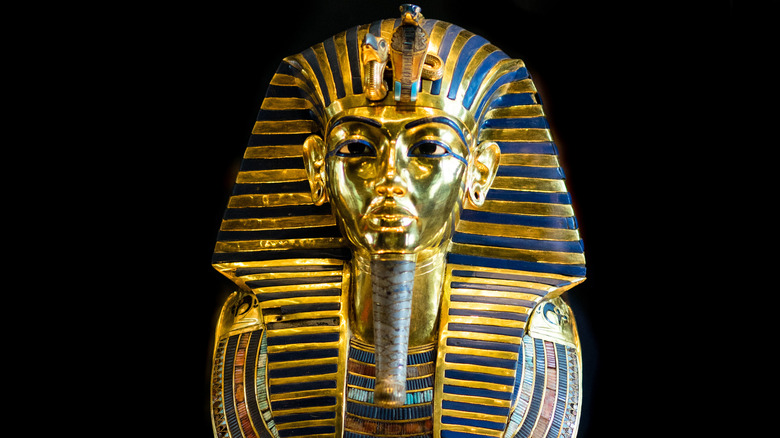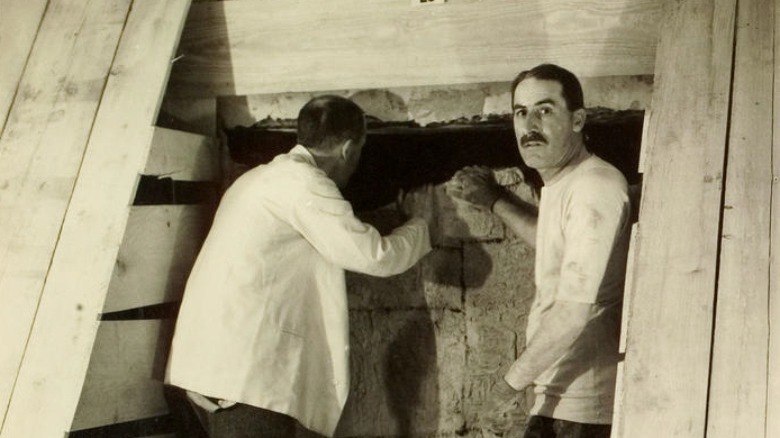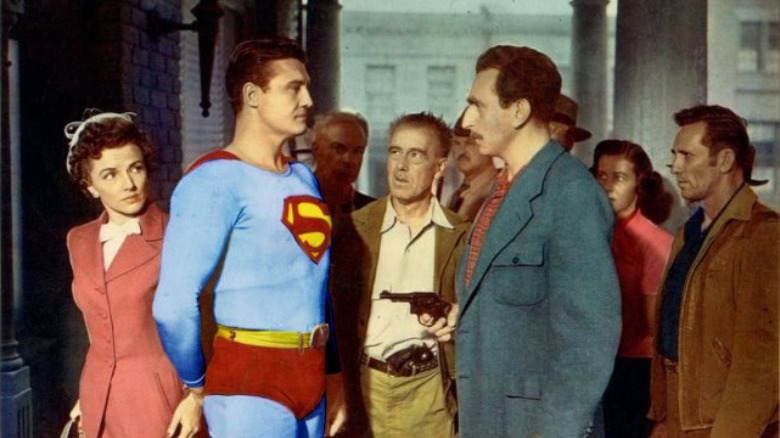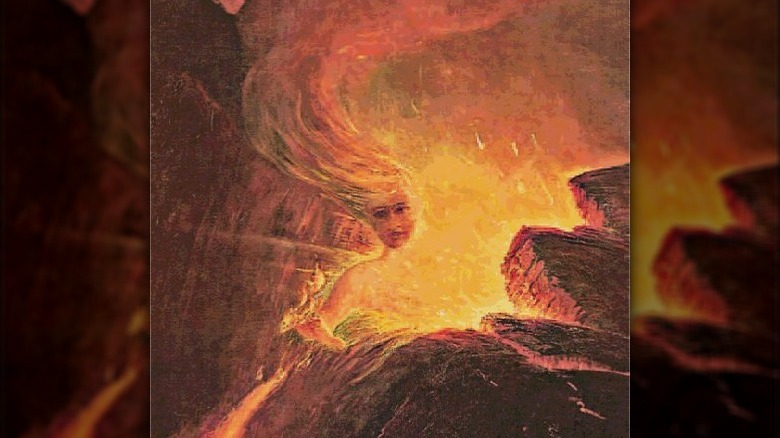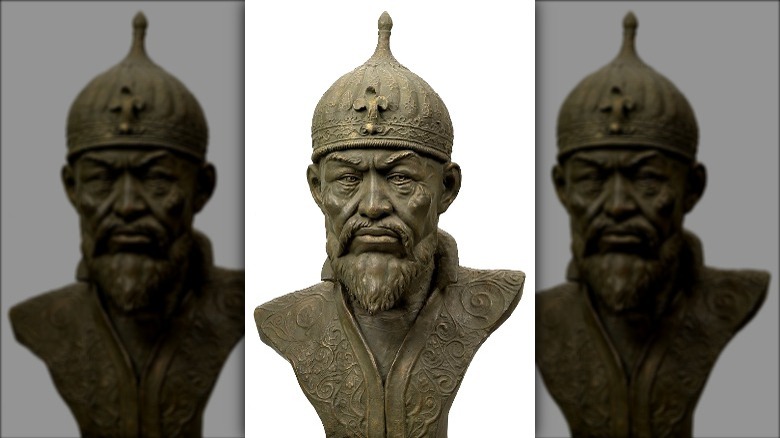Are These The Most Famous Curses Of All Time?
Seen from one perspective, a curse is kind of nice. Someone who is pretty powerless at the moment might just be able to exact some revenge in an arena where politics and firepower don't come into play. And for people whose personal and cultural beliefs hinge on resting in peace forever, it may also come as something of a comfort to think that any tomb robbers will get their just desserts.
Of course, even if you think a curse is justified, you probably don't want to be on the receiving end of one. Death and doom is certainly no fun, and neither is the generic bad luck that trails some other, less dire prophecies. And even if you think that some of a curse's effects are trumped up, the results of a self-fulfilling prophecy, or simply a good old-fashioned case of confirmation bias, it's hard to deny that some curse stories are pretty compelling. If nothing else, some of these most famous curses of all time are pretty well traveled.
The Hope Diamond
According to ThoughtCo, the Hope diamond legend maintains that the current owner of the diamond is subject to misfortune until they get rid of the gigantic, blue-hued gemstone. Even people who touch it are said to come away with serious bad luck. But the truth of the legend is hard to track down. In 1910, jeweler Pierre Cartier said that the Hope diamond had been stolen from a statue of the Hindu goddess Sita. The thief, one Jean Baptiste Tavernier, was later mauled to death by wild dogs.
Throughout the years, it was supposedly owned by some seriously famous and seriously doomed people, including Marie Antoinette and jeweler Simon Montadrides, whose family died after plummeting off a cliff. Then again, it may well have been a canny marketing trick — Cartier told this story while trying to sell the diamond to the incredibly rich Evalyn and Edward Walsh McLean. After all, the real Tavernier died an old man in Russia, having never been torn apart by canines. Yet Evalyn McLean did suffer through the losses of two children and the mental decline of her husband after purchasing the diamond. Supposedly, the curse was "broken" when jeweler Harry Winston donated the Hope diamond to the Smithsonian in 1958.
The Kennedy family curse
Sen. Edward "Ted" Kennedy certainly wondered if his family was cursed. According to CNN, he may well have been thinking about the assassinations of his brothers, President John F. Kennedy and Robert F. Kennedy. Or he could have been considering the deadly record his family has with aircraft. The senator himself survived a 1964 plane crash. Yet, his oldest brother, Joe Jr., had died in another crash in 1944. So had his sister Kathleen in 1948. And his nephew, John F. Kennedy Jr., (along with JFK Jr.'s wife, Carolyn, and sister-in-law Lauren) had perished in yet another small airplane crash in 1999.
As if that weren't enough, other members of the Kennedy family have died from drug overdoses, ski accidents, and congenital lung complications. In 2020, a Kennedy mother and her young son drowned in an apparent boating accident (via NZ Herald). Other Kennedys have been lobotomized, struck by cancer, and convicted of murder. Ted Kennedy's reputation was deeply marred by a 1969 car crash near Massachusetts' Chappaquiddick island, where campaigner Mary Jo Kopechne may well have survived if only Ted had gotten help in time. And yet some still express doubt, including his two sons (one of whom lost a leg to cancer).
Curse of Turan
Can an entire nation be cursed? According to some, the Curse of Turan once darkened the prospects of everyone in Hungary. It may have happened due to an ancient conflict, says "Fodor's Budapest." The story goes that King Stephen of Hungary went about converting everyone to Christianity in 1000 C.E. Possibly a disgruntled shaman of the old religion cursed the newly Christian nation for 1,000 years. Now, that's hard to prove, of course, but some have pointed to the nation's troubles over the years as evidence of the curse. There were all the invasions, including those courtesy of the Mongolian Empire and the Ottomans. Then, the Hungarian Revolution ravaged the nation, while the post World War I Treaty of Trianon gutted the country's landholdings.
Many have also pointed to what they claim is a pervasive sense of doom that seems to haunt the Hungarian people. This may be a cultural myth, but the Annals of General Psychiatry did find that suicide rates in Hungary were unusually high. Yet scientists are more likely to conclude that this is the result of a complex network of social and political factors, and perhaps not the curse of a long-dead Magyar shaman.
If you or anyone you know is having suicidal thoughts, please call the National Suicide Prevention Lifeline at 1-800-273-TALK (8255).
The Curse of Tippecanoe
Known also as "Tecumseh's Curse," the Curse of Tippecanoe, as related by ThoughtCo, all begins with President William Henry Harrison. He won the 1840 election in part by coasting on his role in the 1811 Battle of Tippecanoe against the Shawnee. Though Shawnee leader Tecumseh certainly wasted no love on Harrison, it was actually Tecumseh's brother, Tenskwatawa, who reportedly put the curse on the future president and his successors.
What's evidence of the curse? Harrison did die about a month after his inauguration. However, that's arguably Harrison's fault, as he insisted on delivering an excessively long inaugural speech and staying out in a rainstorm afterward — shocking how that can develop into deadly pneumonia.
But other presidents who won election at the beginning of a decade (an apparently important detail) were also struck down. There's Abraham Lincoln, elected in 1860 and assassinated five years later. James Garfield, elected in 1880, was also shot to death by Charles Guiteau in 1881. William McKinley, elected in 1900, was also shot to death. Warren G. Harding, elected in 1920, was embroiled in the Teapot Dome scandal and died of a stroke while in office. Elected in 1940, FDR survived until 1945 but had to deal with the Great Depression and World War II. And, of course, there's JFK, who was elected in 1960 and shot to death in Dallas in 1963. Yet, Ronald Reagan, after being elected in 1980 survived scandal and a 1981 assassination attempt, as did George W. Bush, elected in 2000, with two known attempted assassinations.
James Dean's Car
James Dean is now one of those Hollywood figures whose glamour comes with a heavy tinge of melancholy. He was a moody teen in 1955's "Rebel Without a Cause," after all. And shortly before the release of "Rebel," Dean died in a car crash when his Porsche Spyder struck another car. Everyone else involved survived (via History).
Dean himself became a legend shortly thereafter. So, too, did his car. The Porsche was pretty badly damaged, says MotorSport, though customizer George Barris would later display a seemingly different car that he claimed was the fatal wreck. In fact, much of the legend appears to stem from Barris, who claimed that one of the first victims of the curse was a mechanic whose legs were crushed when the Spyder slipped while being unloaded. He also said that a man who bought the engine died while racing a car with the new motor, while another was reportedly paralyzed in a car that incorporated a salvaged axle.
Hagerty also reports that a pair of tires from the Spyder nearly got someone else into a wreck when they both blew. Yet, MotorSport notes that Barris was known as a real showman who could well have taken some original bits of Dean's car, covered them with sheet aluminum, and then carefully dented it to support his story (and subsequent pricey sales of purported Spyder car parts).
King Tut's curse
Generally speaking, tomb robbing is bad. Even if you're not related to the individual whose burial is disturbed, most of us surely agree that it's bad manners to go rooting around in someone's final resting place. Only, things get tricky when you're an archaeologist. Should you leave the dead alone, or has enough time passed that you can reasonably add to the historic record by gently shuffling through a mummy's trove?
That's an ongoing and oftentimes contentious debate in modern archaeology (via National Geographic), but past researchers were far more freewheeling, like one Howard Carter. He's best known for unearthing the tomb of ancient Egyptian pharaoh Tutankhamun in 1922. But, as JSTOR Daily notes, maybe even old school Carter and his associates should have left well enough alone. That's because there's reportedly a notorious curse that came along with breaking into Tut's burial place.
A number of people associated with the excavation reportedly died, including financier Lord Carnarvon, who died two months after the tomb opening from blood poisoning. A buddy of Carter's was given a paperweight made from a mummy's hand; his house subsequently burned down. Another financier died of pneumonia shortly after visiting the tomb. Yet, despite the spooky story, it's hard to ignore the fact that Carter himself — who should have been at the epicenter of a mummy's curse — lived until 1939 and died of lymphoma (via Biography). Other expedition members survived for even longer.
The Superman curse
You'd think that the image of the Man of Steel would lend some strength to people who portray him. But, if the rumors are to be believed, there's a serious curse that haunts some of those who have crossed paths with the Kryptonian superhero.
The first victims of the curse may well have been Superman's creators. According to KQED, Jerry Siegel and Joe Shuster came up with the character, who debuted in 1938. Yet, they were never fairly paid for their work, and Shuster even suffered such terrible vision problems that he eventually had to leave comics behind. Max and Dave Fleischer, the brothers who helped to create popular 1940s Superman animated shorts, had a massive falling-out. Max's career seriously faltered, and he eventually became destitute.
When "Superman" hit both the small and big screens, actors complained of typecasting. But some of the worst effects of the supposed curse may have been reserved for George Reeves, who played the character throughout the 1950s. In 1959, he died at age 45. Officially, it was ruled a suicide, but details of the case make some doubt that conclusion. Not enough for you? Christopher Reeve, who played Superman in the 1970s and 1980s, became a quadriplegic after a 1995 accident, though he lived until 2004. Margot Kidder, who played Lois Lane alongside Reeve, went through a horrific car accident and later suffered a serious mental health episode that saw her briefly homeless.
The Iceman
To be fair, no one meant to bother Ötzi's resting place. Per the South Tyrol Museum of Archaeology, this ancient man's remains were uncovered in the Alps on the Italian and Austrian border in 1991. The hikers who stumbled across the body, as well as the first investigators on the scene, initially assumed that these were the remains of a modern person who'd come across serious trouble in the mountains. Subsequent investigations proved that the Iceman, as he also came to be known, was actually thousands of years old. Today, Ötzi (named after Austria's nearby Ötztal Valley), is on view in the South Tyrol Museum.
Maybe it's all that moving about and being put on public display that's got Ötzi a little curse-happy. According to DW, quite a few people have purportedly fallen victim to the "Curse of the Iceman" in the years after his discovery. One of the hikers who found the Iceman, Helmut Simon, died in a mountaineering accident not too far from where he first saw Ötzi. Members of the team who eventually identified the remains also died, including a forensic examiner who was killed in a car crash just before he was set to give a talk about the discovery. Of course, you could also blame disease for some of these deaths, given that conditions like heart attacks, brian tumors, and multiple sclerosis took some of the people involved (years after their involvement, it should be noted).
Pele's curse
In general, being polite pays off. You never know who you're going to encounter, after all, and isn't it easier to go through life with a lighter conscience, anyway? There's even more incentive to behave yourself when a powerful goddess might be watching.
Certainly keep this in mind if you visit or happen to live in Hawaii. That's because doing something as seemingly innocuous as snagging a rock can reportedly put you in the crosshairs of Pele, the volcano goddess of the islands. Pacific Standard reports that quite a few people in recent decades have sent rocks and other small pieces of the island (typically the "Big Island," also known as the island of Hawaii) back to various post offices. Their hope? That, by returning what they've taken from Pele, she'll relent and give them back some of their previous good fortune.
The woes inflicted by Pele include everything from death, to car accidents, to imprisonment, to unsatisfactory lottery winnings (that last one may be a bit privileged, admittedly). However, some people who receive the packages are frustrated, saying that the "curse" doesn't reflect Native Hawaiian belief at all. What's more, it's illegal to take anything from a national park, whether that's a cool-looking lava rock or a flower. So, even if you're skeptical of the curse when you visit the islands, be a conscientious tourist and just take a picture instead.
Macbeth
Perhaps you already know that uttering the name of a certain play while inside a theater is, for many actors, a serious transgression. You know, that play. The Shakespeare one with all of the spooky witches and ominous ghosts and meditating on death and betrayal. If you must refer to it, please do so by alternate monikers like "The Scottish Play." Otherwise, you'll either face bad luck or the wrath of theater people — either of which is probably just as unpleasant as the other.
This is the curse of Shakespeare's "Macbeth." According to The Guardian, the exception to the rule is, of course, if a group is staging a live performance of the play. Otherwise, uttering the name "Macbeth" is said to invoke the dark arts associated with the play, which reportedly scared some theater-goers when it first premiered around 1606.
What are the ill effects? There are some genuine documented mishaps associated with the play, like the 1937 production headlined by Laurence Olivier where the theater manager died, the director and an actor were in a car crash, and Olivier himself was nearly brained by a plummeting weight. Earlier in history, one actor was accidentally killed on stage in 1672, and multiple riots plagued productions in 1721, 1722, and 1849.
The Chicago Cubs
You've probably heard of any number of sports curses that have supposedly doomed a given team or individual players. The Madden Curse is said to cast a dark cloud over the careers of players who appear on the cover of the "Madden" football video game, for instance (via Sports Illustrated). Meanwhile, the vengeful spirit of Colonel Sanders was believed to have hampered Japan's Hanshin Tigers baseball team after fans threw a KFC statue into Osaka's Dotonbori River in 1985.
Then there's the curse of the goat, said to have been the source of decades of heartbreak for the Chicago Cubs. As USA Today has it, it all started in 1945 when bar proprietor William "Billy Goat" Sianis wasn't allowed to enter Wrigley Field to view that year's World Series with his actual pet goat, Murphy. Apparently, Sianis had purchased a ticket for Murphy, but the animal's stench was so powerful that he was barred from entry anyway. Sianis reportedly uttered this ominous phrase: "You are going to lose this World Series and you are never going to win another World Series again." Indeed, they didn't win a world series until many decades later, in 2016 (via Chicago Tribune).
The Cubs have blamed other incidents for their long dry spell, reports Major League Baseball, from a black cat strolling onto the field in 1969, to a glove doused in Gatorade, to an unfortunate fan who accidentally knocked the ball away from a catcher.
Timur
If excavating any old grave is a pretty tricky proposition, ethically speaking, then surely cracking open the tomb of a notoriously ruthless conqueror is a pretty bad idea. Timur was a medieval conqueror born in the 14th century in what's now Uzbekistan (via Britannica). Over the course of his career, he occupied Moscow, reduced Delhi to ruins, did the same to Damascus, and generally spread terror wherever he went.
Centuries after Timur's 1405 death, another iron-fisted ruler reportedly decided to mess with the man's remains. According to "Cursed Objects," by J.W. Ocker, that man was none other than Joseph Stalin, Soviet dictator. In 1941, archaeologists in Uzbekistan (then part of the Soviet Union) exhumed what they believed to be Timur's body from his tomb, doing so under Stalin's directive. Only days after their investigation, Nazi Germany invaded the Soviet Union. Naturally enough, rumors began to circulate that Timur's mausoleum was inscribed with warnings, with one supposedly reading "Whosoever opens my tomb shall unleash an invader more terrible than I."
It's a pretty good story, though there's no proof that such a perfect inscription actually exists. Then again, once researchers put Timur's bones back, the Soviets did prevail over Germany at Stalingrad. For many, that coincidence was just too much to ignore.
